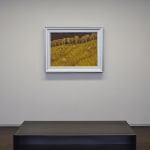Higashiyama Kaii (1908−1999)
Golden Glow
Color and gold on paper, framed
With a label signed by the artist, a Higashiyama Sumi certificate
Seal: Kaii
63 x 87.5 cm
85 x 110 cm (overall)
With a label signed by the artist, a Higashiyama Sumi certificate
Seal: Kaii
63 x 87.5 cm
85 x 110 cm (overall)
Further images
Exhibitions
The 8th Seiyokai Exhibition. Tokyo: Nihonbashi Mitsukoshi, 1960.Higashiyama Kaii ten. Tokyo: Nihonbashi Takashimaya, 1989.
Higashiyama Kaii ten. Fukuoka: Fukuoka Mitsukoshi; Tokyo: Nihonbashi Mitsukoshi; Nagoya: Matsuzakaya Art Museum, 2000.
and others
Literature
Higashiyama Kaii zenshu 2: Fukei junrei II. Tokyo: Kodansha, 1980.Higashiyama Kaii jisen gabunshu 1. Tokyo: Shueisha, 1996.
KAIÏ HIGASHIYAMA CATALOGUE RAISONNÉ. Tokyo: Kyuryudo, 2004.
and others
This work depicts the scenery of Mikuni-toge Pass on the border of Gunma and Niigata prefectures. The work was exhibited in the Eighth Seiyo-kai Exhibition held in 1960 at Mitsukoshi department store in Nihonbashi, Tokyo. Another work of the same title, Golden Glow, shown in the “Fourth New Nitten Exhibition” in 1961, is often regarded as one of Higashiyama Kaii’s signature works. The New Nitten work remarkably composes the silhouette of the trees standing on the right, whereas the present work adopts a distanced viewpoint, generating an unusual perspective that guides the viewer to the top of the pass. Kaii focuses on the faithful depiction of the yellow foliage, representing the natural and splendor beauty of the Mikuni-toge Pass. Looking closely at the work, the viewer can even hear the sublime symphony of the woods in the breeze.
Higashiyama Kaii (nihonga painter; 1908–1999)
Kanagawa-born nihonga painter. His real name is Shinkichi. A student of Yuki Somei at Tokyo School of Fine Arts. In 1947, his work, Zansho, was given the tokusen (special prize that grants entry without examination in the following year) at Nitten (The Japan Fine Arts Exhibition). His refined techniques and the manner on depicting the feelings of nostalgia towards the lands he rooted earned him high recognition in the art world. His mural paintings in Miei-do at Toshodai-ji Temple are regarded as his signature works and highly praised. Director of Nitten. The Japan Art Academy member. Designated a Person of Cultural Merit, and received the Order of Culture.
Higashiyama Kaii (nihonga painter; 1908–1999)
Kanagawa-born nihonga painter. His real name is Shinkichi. A student of Yuki Somei at Tokyo School of Fine Arts. In 1947, his work, Zansho, was given the tokusen (special prize that grants entry without examination in the following year) at Nitten (The Japan Fine Arts Exhibition). His refined techniques and the manner on depicting the feelings of nostalgia towards the lands he rooted earned him high recognition in the art world. His mural paintings in Miei-do at Toshodai-ji Temple are regarded as his signature works and highly praised. Director of Nitten. The Japan Art Academy member. Designated a Person of Cultural Merit, and received the Order of Culture.







